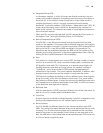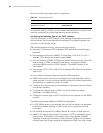
OSPF 81
[Switch B-rip]network 110.11.2.0
3 Configure RIP on Switch C:
[Switch C]rip
[Switch C-rip]network 117.102.0.0
[Switch C-rip]network 110.11.2.0
Troubleshooting RIP The Switch 8800 cannot receive update packets when the physical connection to
the peer routing device is normal.
■ RIP does not operate on the corresponding interface (for example, if the undo
rip work command is executed) or this interface is not enabled through the
network command.
■ The peer routing device is configured for multicast mode (for example, the rip
version 2 multicast command is executed) but the multicast mode has not
been configured on the corresponding interface of the local switch.
OSPF Open Shortest Path First (OSPF) is an Interior Gateway Protocol (IGP). At present,
OSPF version 2 (RFC2328) is used, which has the following features:
■ Scope — Supports networks of various sizes and can support several hundred
routers
■ Fast convergence — Transmits the update packets instantly after the network
topology changes so the change is synchronized in the AS
■ Loop-free — Calculates routes using the shortest path tree algorithm,
according to the collected link states so that no loop routes are generated from
the algorithm itself
■ Area partition — Allows the network of AS to be divided into different areas
for management convenience, so that the routing information that is
transmitted between the areas is further abstracted to reduce network
bandwidth consumption
■ Equal-cost multi-route — Supports multiple equal-cost routes to a destination
■ Routing hierarchy — Supports a four-level routing hierarchy that prioritizes
routes into intra-area, inter-area, external type-1, and external type-2 routes.
■ Authentication — Supports the interface-based packet authentication to
guarantee the security of the route calculation
■ Multicast transmission — Uses multicast addresses to send updates.
Configuring OSPF is described in the following sections:
■ Calculating OSPF Routes
■ Configuring OSPF
■ Troubleshooting OSPF
Calculating OSPF Routes The OSPF protocol calculates routes in the following way:
■ Each OSPF-capable router maintains a Link State Database (LSD), which
describes the topology of the entire AS. According to the network topology
around itself, each router generates a Link State Advertisement (LSA). The
routers on the network transmit the LSAs among themselves by transmitting


















